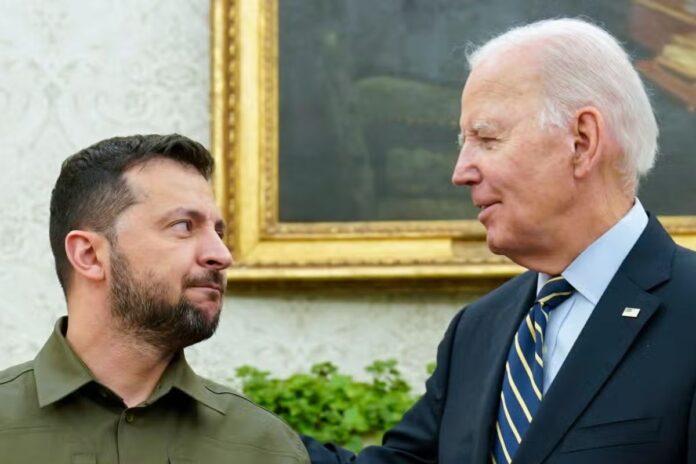In a historic policy shift, President Joe Biden’s administration has authorised Ukraine to use U.S.-made weapons for strikes deep within Russian territory. This decision, confirmed by two U.S. officials and another source familiar with the matter, marks a pivotal moment in the Ukraine-Russia conflict, signalling a significant departure from Washington’s earlier stance of restraint. The move comes as Ukraine faces mounting pressure from advancing Russian forces and the deployment of North Korean troops to bolster Moscow’s ranks.
Ukraine’s Long-Range Plans Take Shape
Sources indicate that Ukraine is preparing its first long-range attacks in the coming days, though specific details remain undisclosed for security reasons. This development follows persistent appeals from Ukrainian President Volodymyr Zelenskiy, who has long sought permission to utilise U.S. weapons to target Russian military installations far from the frontlines.
“Today, many in the media are saying that we have received permission to take appropriate actions,” Zelenskiy stated in his evening address. “But strikes are not made with words. Such things are not announced.”
The White House and State Department have declined to comment on the matter. However, the move aligns with the Biden administration’s effort to ensure Ukraine is well-equipped to counter Russian advances before President-elect Donald Trump takes office on January 20.
Rationale Behind the Shift
This decision appears to be driven by Russia’s alarming reliance on foreign allies to sustain its war efforts. The deployment of more than 10,000 North Korean troops to eastern Russia has heightened concerns in Kyiv and Washington. U.S. intelligence suggests that many of these troops are actively engaging in combat operations in the Kursk region, where Ukrainian forces have recently suffered setbacks.
Ukraine’s military, already stretched thin, has been unable to maintain gains made during its August incursion into Russian territory. Analysts believe that loosening restrictions on U.S. weapons could provide a much-needed boost to Ukraine’s capabilities.
“Removing targeting restrictions will allow the Ukrainians to stop fighting with one hand tied behind their back,” said Alex Plitsas, a senior non-resident fellow at the Atlantic Council. “However, like everything else, I believe history will say the decision came way too late.”
Concerns of Escalation and Global Reactions
While Ukraine celebrates this newfound flexibility, the Kremlin has warned of severe consequences. Vladimir Dzhabarov, a senior Russian official, labelled the decision a potential catalyst for “World War Three,” while Andrei Klishas, another prominent figure, declared that the escalation could leave Ukraine in ruins.
Poland’s foreign minister, Radoslaw Sikorski, framed Biden’s move as a direct response to Russia’s use of North Korean troops and recent missile attacks. “President Biden responded to the entry of North Korean troops into the war and the massive Russian missile strike in a language that V. Putin understands – by removing restrictions on Ukraine’s use of Western missiles,” Sikorski remarked.
Ukraine is expected to deploy ATACMS rockets with a range of up to 190 miles (306 kilometers) for its upcoming operations. While some U.S. officials remain skeptical about the long-term impact of these strikes, they acknowledge the potential to improve Ukraine’s negotiating position in future peace talks.
Political Ramifications in the U.S.
As Biden’s term nears its end, questions arise about how Trump’s return to the White House might affect this policy. Trump, who has frequently criticized U.S. military aid to Ukraine, has vowed to end the war swiftly, though he has yet to provide a detailed plan. Richard Grenell, one of Trump’s close advisors, criticized Biden’s decision as reckless.
“Escalating the wars before he leaves office,” Grenell posted on X (formerly Twitter).
Republican lawmakers, however, appear divided. While some have applauded Biden for finally loosening the restrictions, others argue that the move is overdue. Representative Mike Turner, who chairs the House Intelligence Committee, welcomed the decision but emphasized the need for further action.
“This first step will put pressure on Vladimir Putin as President-elect Trump returns to the White House and works to end this war,” Turner said.
Implications for NATO and Global Stability
The Biden administration’s decision underscores the delicate balance NATO allies must maintain. While supporting Ukraine’s right to defend itself, Western nations remain cautious about provoking Russia into retaliatory actions that could escalate into a broader conflict. Previous arms shipments to Ukraine often came with restrictions on their use inside Russian territory to avoid such risks.
Despite these concerns, Ukraine’s allies are increasingly recognizing the need for a robust response to Russian aggression. The massive influx of North Korean troops into the conflict has underscored the urgency of empowering Ukraine’s military. Zelenskiy’s appeals for more comprehensive support have found renewed resonance as the war enters a critical phase.
Future Uncertainties
The coming weeks will be crucial in determining the impact of Biden’s decision. If Ukraine successfully leverages its newfound capabilities, it could regain lost ground and strengthen its position in potential ceasefire negotiations. However, the risk of escalation remains ever-present, particularly as Russia adapts to Ukraine’s evolving strategy.
For Zelenskiy and Ukraine, the stakes could not be higher. Facing an emboldened adversary backed by foreign allies, the ability to strike deep into Russian territory represents not just a tactical advantage but also a powerful symbol of resilience. Yet, as the conflict intensifies, the world watches anxiously, bracing for the consequences of this bold and unprecedented policy shift.

